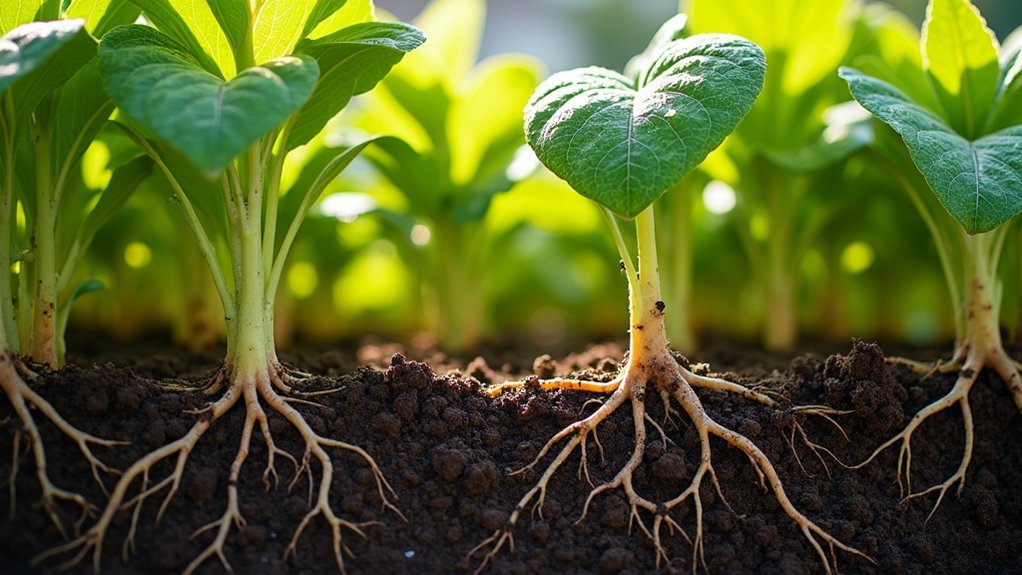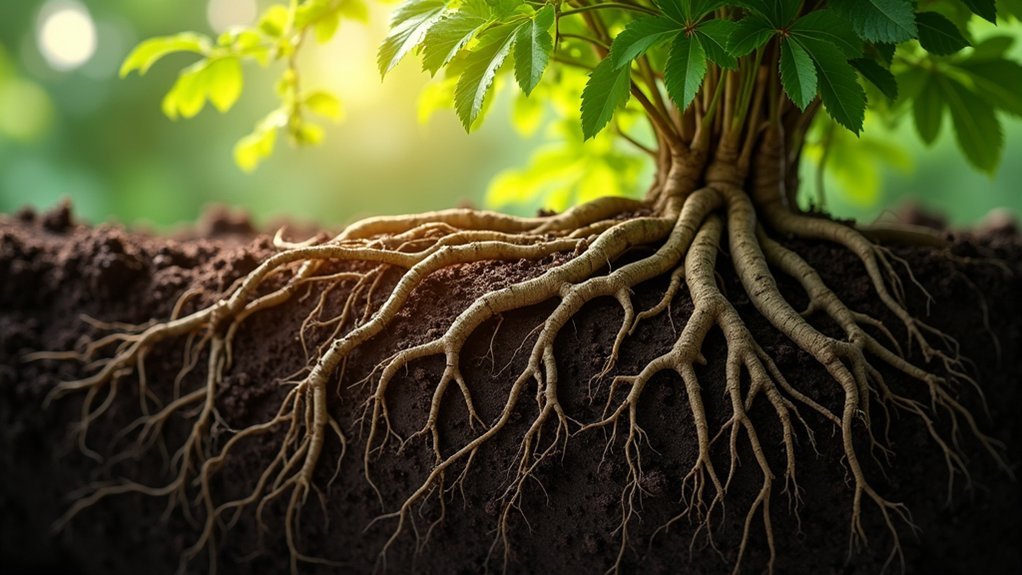Effective root boundaries require spacing based on tree size: small trees need 10 feet, medium trees 20 feet, and large trees 30-50 feet apart. You should calculate minimum distance as 3.5 times the tree’s diameter at breast height (DBH) or at least 1.5 meters. For barrier installation, stay beyond the Structural Root Zone while directing roots downward. Soil type matters too—clay soils need deeper barriers (up to 60 inches) while sandy soils require wider coverage. These spacing principles prevent future encroachment issues.
Tree Root Spacing Guidelines for Creating Living Barriers

When establishing effective root barriers, understanding proper spacing is essential for both tree health and structural protection. Follow the minimum distance formula of 3.5 times the tree’s diameter at breast height (DBH) or 1.5 meters, whichever is greater.
Never encroach on the Structural Root Zone (SRZ) as defined by Australian Standard AS 4970, as this maintains tree stability. Your barrier placement should redirect roots downward without compromising the tree’s anchorage system.
Protect the Structural Root Zone at all costs — your barrier must guide roots without destabilizing the tree’s foundation.
Research shows that barriers installed within a 3-foot radius of the trunk effectively reduce root biomass while allowing healthy growth.
For clay soils, extend your barrier depth up to 60 inches, while sandy soils require wider barriers to compensate for their looser structure. A comprehensive site evaluation should be conducted to identify utility line locations before excavation begins to ensure safety and prevent unnecessary complications during installation.
Calculating Optimal Distances Between Root Systems
Determining the right distance between tree root systems requires a scientific approach rather than guesswork. Use trunk diameter as your primary metric instead of relying on canopy spread or tree height for more accurate planning.
For most species, roots extend 1.5 to 3 times the tree’s height radially, with structural roots reaching less distance but causing more potential conflicts. Small trees need at least 10 feet of spacing, medium trees require 20 feet, and large trees demand 30-50 feet between them.
Consider soil conditions too—shallow or compacted soil forces roots to spread more horizontally. In well-conditioned soil, expect 16-24 inches of depth for healthy root development. Sandy soils encourage deeper penetration while dense soils promote lateral expansion. For optimal growth, vegetables with different rooting depths can be strategically planted together, as deep-rooted vegetables will access nutrients from lower soil layers without competing with shallow-rooted varieties.
These calculations help you prevent root competition and structural damage while maintaining healthy tree growth.
Native Species Selection for Root Boundary Development

Selecting native species for effective root boundary development demands understanding their unique ecosystem roles and biological characteristics.
You’ll want plants with diverse root traits that adapt to your specific soil conditions and create effective underground barriers. Choose species with competitive abilities against invasives and those that fill ecological niches in your ecosystem.
Consider plants adapted to your local soil resources and climate, as these will establish stronger root systems and engage in beneficial belowground competition.
For long-term success, incorporate seral native species that support succession dynamics. Plants with extensive root systems prevent soil erosion while maintaining the boundary’s integrity.
Collecting native seeds from successful local populations increases your survival rates, while mixing growth forms enhances your ecosystem’s resilience and creates a more robust root boundary. Select thin-rooted plants like those in the Fynbos biome if developing root boundaries in areas with low soil resources.
Maintenance Techniques for Established Root Boundaries
Successfully maintaining established root boundaries requires consistent monitoring and intervention strategies to prevent unwanted encroachment.
Regular inspections help you identify root heaving, monitor structures, and check soil moisture levels before problems escalate.
Stay vigilant with scheduled inspections to catch root issues while they’re still manageable and preventable.
Proper soil management is essential—incorporate organic mulch, install subsurface drainage, and water deeply but infrequently to encourage downward growth.
When barriers show signs of failing, reinforce them with HDPE liners or extend their depth based on root behavior.
For problematic roots, perform strategic pruning during dormancy periods, but avoid over-pruning which can trigger compensatory surface growth.
Consider redirecting roots using trenched guides instead of removing them.
Don’t hesitate to consult arborists annually for thorough evaluations, especially when dealing with mature trees or complex root systems. The most effective boundaries typically target common offenders like poplars, willows, and silver maples, which are known for their particularly aggressive root systems.
Troubleshooting Common Root Encroachment Issues

Root encroachment issues often emerge despite our best maintenance efforts, requiring prompt identification and targeted solutions. When you notice cracks in your foundation or uneven door frames, you’re likely facing tree root invasion, especially in clay-rich soils where moisture fluctuations exacerbate the problem. Severe structural damage can result from ignoring the problem for extended periods of time.
| Issue | Likely Cause | Solution |
|---|---|---|
| Foundation cracks | Roots within 10-30 feet | Install root barrier 24-36″ deep |
| Buckling pavement | Shallow-rooted species | Root pruning (preserve ≥50% mass) |
| Uneven floors | Clay soil shrinkage | Maintain consistent soil moisture |
| Declining garden | Resource competition | Select deep-rooted species |
| Persistent regrowth | Inadequate barriers | Biannual inspections & root collar checks |
Don’t wait until damage worsens—early intervention through regular inspections and moisture monitoring will save you significant repair costs later.
Frequently Asked Questions
How Do Soil Ph Levels Affect Root Boundary Effectiveness?
You’ll maximize root boundary effectiveness when soil pH is 6.2-6.8. Acidic soils (below 6.0) cause toxic conditions and alkaline soils (above 7.5) reduce nutrient availability, both weakening your plant’s root development and spread.
Can Companion Planting Strengthen or Weaken Root Boundaries?
Companion planting can both strengthen and weaken root boundaries. You’ll see benefits when you pair shallow and deep-rooted plants, but risk damage with allelopathic combinations like onions near beans that inhibit root development.
Do Seasonal Changes Impact Root Boundary Spacing Requirements?
Yes, seasonal changes directly impact your root boundary spacing requirements. You’ll need wider spacing during active growth periods and can reduce it during dormancy as root activity and water competition fluctuate throughout the year.
Are Root Barriers Necessary When Using Proper Spacing Techniques?
You’ll still need root barriers for most landscape scenarios, even with proper spacing. They’re especially critical for invasive species, urban settings with space constraints, and properties with varying soil compositions that accelerate root spread.
How Do Pollinator-Friendly Plants Integrate With Root Boundary Systems?
You can integrate pollinator-friendly plants with root boundary systems by selecting species with compatible root depths, incorporating them in groups, and using native plants that attract beneficial insects while respecting spacing requirements for healthy roots.
In Summary
You’ll need to maintain at least 15-20 feet between large trees to create effective root boundaries. Remember that you’re establishing living barriers that require ongoing care. By selecting appropriate native species, calculating proper spacing, and implementing regular maintenance, you’ll prevent unwanted root encroachment. Don’t forget to inspect annually and prune as needed. With these practices, you’re ensuring both healthy trees and properly defined boundaries.





Leave a Reply